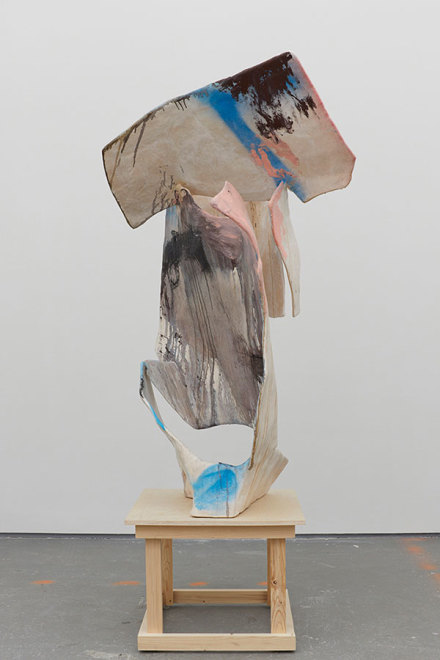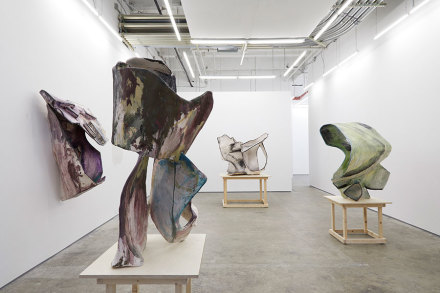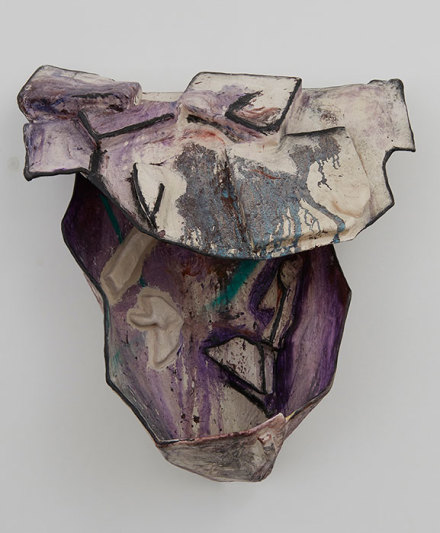
Ernesto Burgos, Mancha (2017), all images via Kate Werble Gallery
Artist Ernesto Burgos is presenting seven new pieces for his third solo show with Kate Werble Gallery up through May 6th. For the past five years, Burgos has continued to make organic, sculptural forms from fiberglass, which he then paints over using a range of materials including spray paint, charcoal, oil stick and lacquer, embellishing his pieces with an additional layer of gestural mark-making. Here, Burgos continues his investigation of form and material while experimenting with the size and presentation of his work.
Upon entering the gallery, one is immediately struck by the scale of these works in comparison with previous, more modestly-sized pieces. With this shift in dimension the sculptures are no longer object-like, instead taking on an anthropomorphic aspect via their proportion to the human body. Six pieces are placed atop simple wooden tables, similar to those that he uses in his studio. Throughout, experimentation with the work’s exhibition is a running thread. In the past he has used the classic white cube pedestal, but will often opt to place work at varying heights, controlling the navigation of the eye around the space, and how one approaches each sculpture. He uses this tactic here to strong effect, but also plays with balance, juxtaposing what appears-to-be very heavy sculpture on top of small, wooden tables. This is seen most clearly in Elision (2017), one of the largest sculptures in the show. Burgos places it on the smallest pedestal, exploring a subtle anxiety that it might topple over at the slightest touch.

Ernesto Burgos, Elision (2017)
Burgos’ working methods allow for impressive control of his forms, while maintaining an acceptance for the way each form unfolds naturally. To begin a piece, he makes a precarious armature out of cardboard, stabilizing portions of the work by applying fiberglass to that section, allowing him to play with the rest of the form until he has come to a satisfactory point of conclusion. Some of the works here mark a notable departure from previous practice, conjoining multiple pieces of material as opposed to working solely with one piece of cardboard. In this way, Burgos challenges the sculpture by jamming together disparate forms, resulting in shapes that present themselves as naturally integrated.

Ernesto Burgos, One Thing After Another (Installation View)
The piece Predilection of Symmetry (2017) contradicts this synthesis of forms (as well as its own title), marking distinct a departure from the rest of the works on view. Its overall shape resembles that of a urinal, or a receptacle of some kind, yet it is visually clear where he has added various new shapes and aspeccts. Some are outlined in black, drawing even more attention to the fact that they jut out from the work’s surface. It is also the only piece in the show he has chosen to hang on the wall, marking a new direction in his work’s trajectory.

Ernesto Burgos, Predilection of Symmetry (2017)
Burgos often works on a group of pieces at the same time – this body of work is no exception. While in the studio he will leave one to focus on another, then circle back, developing the sculptures together simultaneously. The title of the show, One Thing After Another, alludes to this method of working, and the relationship between all of the pieces. Though the color palette is not the same for each, particular shades of greens, purples and reds do recur throughout the group of seven. Burgos often applies the paint with his hands, allowing the form to dictate his choices, resulting in an often wild, raw materiality. In certain parts, his uninhibited application of the materials appears to be almost violent and destructive.

Ernesto Burgos, One Thing After Another (Installation View)

Ernesto Burgos, Both Directions (2017)
Burgos presents sculptures that are disheveled, yet simultaneously refined at the same time, an exchange struck between the elegance of the form covered in his unimpeded mark making. Upon inspection, one can trace all the imperfections of the mold, places where hair or bits may have gotten caught, or moments of harried application of paint. He has chosen not to sand the fiberglass in some places, leaving it to appear almost skin-like underneath the paint. Throughout the show there is the sense that he is in control but simultaneously wishes to relinquish restrictions on the work to allow for it to breathe on its own. He purposefully opts not to polish the blemishes away, for they are evidence of their creation.
One Thing After Another is up through May 6th, 2017
— A. Marchak
Read More:
Ernesto Burgos at Kate Werble Gallery [Exhibition Page]



